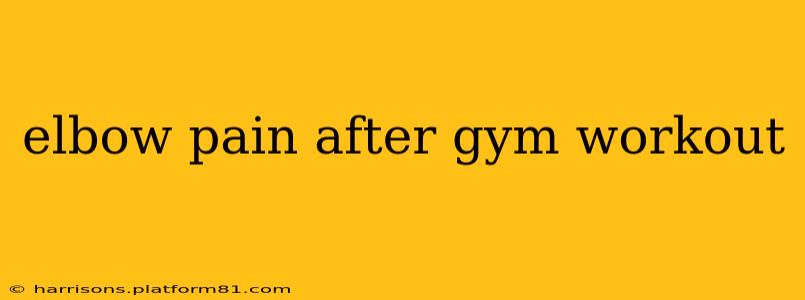Elbow pain after a gym workout is a common complaint, affecting athletes and fitness enthusiasts alike. Understanding the causes, implementing preventive measures, and knowing when to seek professional help are crucial for maintaining your fitness routine and avoiding long-term issues. This comprehensive guide will address the most frequent questions surrounding post-workout elbow pain.
What causes elbow pain after a workout?
Several factors can contribute to elbow pain following a gym session. The most common culprits include:
-
Overuse Injuries: Repetitive movements like weightlifting, especially with improper form, can strain the tendons and ligaments around the elbow, leading to conditions like tennis elbow (lateral epicondylitis) or golfer's elbow (medial epicondylitis). These involve inflammation of the tendons that attach to the outer (tennis elbow) or inner (golfer's elbow) part of the elbow.
-
Muscle Strains: Intense workouts, particularly those focusing on the biceps, triceps, and forearm muscles, can cause muscle strains or tears, resulting in elbow pain. This pain may be felt directly in the muscle or radiate to the elbow joint.
-
Ligament Sprains: While less common, forceful movements or falls can sprain the ligaments supporting the elbow joint, causing pain and instability.
-
Bursitis: The bursae are small fluid-filled sacs that cushion the joints. Repetitive stress can inflame these bursae, leading to bursitis and elbow pain.
-
Fractures: In rare cases, severe trauma during a workout can cause a fracture in the elbow. This usually presents with severe pain and limited movement.
-
Nerve Irritation: Certain exercises or positions can compress or irritate nerves in the elbow area, leading to pain, numbness, and tingling. Cubital tunnel syndrome, for example, involves compression of the ulnar nerve at the elbow.
How do I prevent elbow pain after working out?
Prevention is key to avoiding elbow pain. Here are some crucial strategies:
-
Proper Warm-up: Always begin with a dynamic warm-up that includes exercises to increase blood flow and prepare your muscles and joints for exercise.
-
Correct Form: Pay meticulous attention to your form during each exercise. Using improper form dramatically increases your risk of injury. Consider consulting a qualified personal trainer to ensure you're using correct techniques.
-
Progressive Overload: Gradually increase the weight, reps, and sets over time to avoid overwhelming your muscles and joints. Avoid sudden jumps in intensity.
-
Rest and Recovery: Allow your muscles and joints adequate time to recover between workouts. Overtraining is a significant contributor to elbow pain.
-
Strengthening and Stretching: Incorporate exercises that strengthen the muscles surrounding the elbow joint and improve flexibility. Regular stretching can help prevent muscle tightness and injury.
-
Listen to Your Body: If you experience any pain, stop the exercise immediately. Ignoring pain can lead to more significant injuries.
What are the common treatments for elbow pain after a workout?
Treatment for elbow pain depends on the severity and cause. Mild pain can often be managed with:
-
RICE Method: Rest, Ice, Compression, and Elevation are essential first steps. Apply ice for 15-20 minutes at a time, several times a day.
-
Over-the-Counter Pain Relievers: Nonsteroidal anti-inflammatory drugs (NSAIDs) like ibuprofen or naproxen can help reduce pain and inflammation.
-
Physical Therapy: A physical therapist can design a personalized program of exercises and stretches to strengthen the muscles around the elbow, improve flexibility, and reduce pain.
For more severe or persistent elbow pain, your doctor may recommend:
-
Corticosteroid Injections: These injections can help reduce inflammation in the affected area.
-
Surgery: Surgery is rarely necessary but may be considered for severe cases that don't respond to other treatments.
How long does elbow pain from a workout usually last?
The duration of elbow pain varies widely depending on the severity of the injury and the individual's response to treatment. Mild strains or sprains may resolve within a few days or weeks with rest and home care. More severe injuries, such as tendonitis or ligament sprains, may require several weeks or even months of treatment and rehabilitation.
When should I see a doctor for elbow pain after a workout?
It's crucial to seek medical attention if your elbow pain:
- Is severe or doesn't improve after a few days of home care.
- Is accompanied by numbness, tingling, or weakness in your arm or hand.
- Limits your range of motion significantly.
- Is accompanied by swelling or deformity of the elbow.
- Persists despite rest and over-the-counter pain relief.
This information is for general knowledge and does not constitute medical advice. Always consult a healthcare professional for diagnosis and treatment of any medical condition.
